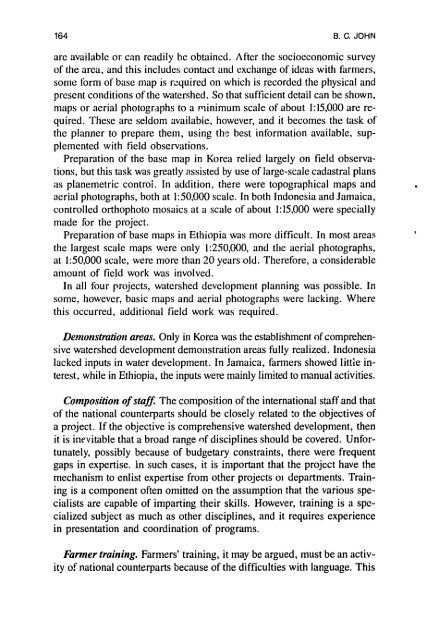Conservation farming on steep lands - USAid
Conservation farming on steep lands - USAid
Conservation farming on steep lands - USAid
Create successful ePaper yourself
Turn your PDF publications into a flip-book with our unique Google optimized e-Paper software.
164 B. C. JOHN<br />
are available or can readily be obtained. After the socioec<strong>on</strong>omic survey<br />
of the area, and this includes c<strong>on</strong>tact and exchange of ideas with f 'irmers,<br />
s<strong>on</strong>ic form of base map is rcquired <strong>on</strong> which is recorded the physical and<br />
present c<strong>on</strong>diti<strong>on</strong>s of the watershet!. So that sufficient detail can be shown,<br />
maps or aerial photographs to a minimum scale of about 1:15,000 are required.<br />
These are seldom availabie, however, and it becomes the task of<br />
the planner to prepare them, using th.: best informati<strong>on</strong> available, supplemented<br />
with field observati<strong>on</strong>s.<br />
Preparati<strong>on</strong> of the base map in Korea relied largely <strong>on</strong> field observati<strong>on</strong>s,<br />
but this task was greatly ~ssisted by use of large-scale cadastral plans<br />
;IS planemetric c<strong>on</strong>troi. In additi<strong>on</strong>, there were topographical maps and<br />
aerial photographs, both at 1:50,000 scale. In both Ind<strong>on</strong>esia and Jamaica,<br />
c<strong>on</strong>trolled orthophoto n~osaics at a scale of about 1:15,000 were specially<br />
made for the project.<br />
Preparati<strong>on</strong> of base maps in Ethiopia was more difficult. In most areas<br />
the largest scale maps were <strong>on</strong>ly 1:250,000, and the aerial photographs,<br />
at 1:50,000 scale, were more than 20 years old. Therefore, a c<strong>on</strong>siderable<br />
amount of field work was involved.<br />
In all four projects, watershed developmerlt planning was possible. In<br />
some, however, basic maps and aerial photographs were lacking. Where<br />
this occurred, additi<strong>on</strong>al field work was required.<br />
Dern<strong>on</strong>stmtiort arzas. Only in Korea was the establishment of comprehensive<br />
watershed development dem<strong>on</strong>strati<strong>on</strong> areas fully realized. Ind<strong>on</strong>esia<br />
lacked inputs in water development. In Jamaica, farmers showed little interest,<br />
while in Ethiopia, the inputs were mainly limited to manual activities.<br />
Composiliort of staff. The compositi<strong>on</strong> of the internati<strong>on</strong>al staff and that<br />
of the nati<strong>on</strong>al counterparts should be closeljl related :o the objectives of<br />
a project. If the objective is com~rehensive watershed development, then<br />
it is inevitable that a broad range of disciplines should be covered. Unfortunately,<br />
possibly because of budgetary c<strong>on</strong>straints, there were frequent<br />
gaps in expertise. in such cases, it is important that the projcct have the<br />
mechanism to enlist expertise from other projects 01 departments. Training<br />
is a comp<strong>on</strong>ent often omitted <strong>on</strong> the assumpti<strong>on</strong> that the various specialists<br />
are capable of imparting their skills. However, training is a spccialized<br />
subject as much as other disciplines, and it requires experience<br />
in presentati<strong>on</strong> and coordinati<strong>on</strong> of programs.<br />
Fanner training. Farmers' training, it may be argued, must be an activity<br />
of nati<strong>on</strong>al counterparts because of the difficulties with language. This
















